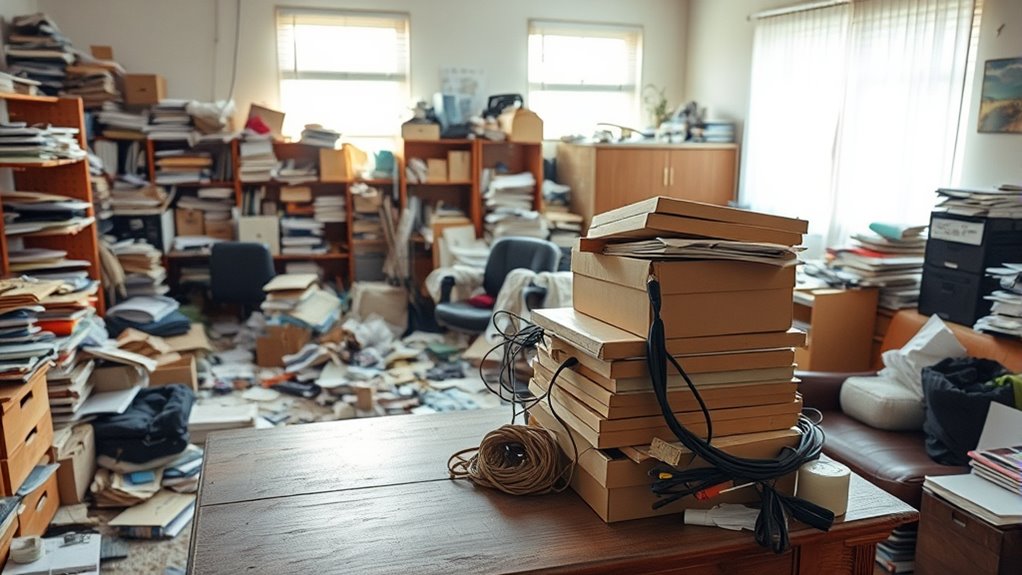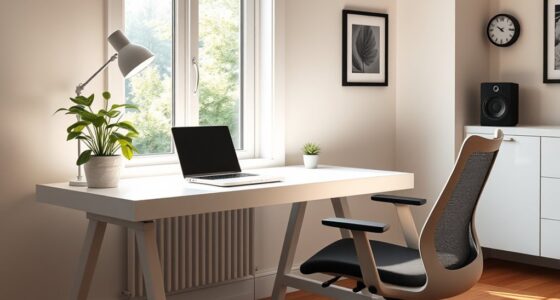Decluttering often fails because focusing on one-time cleanouts doesn’t build lasting habits or systems to prevent re-cluttering. Without routines and mindful habits, clutter tends to return quickly, and emotional attachments can make letting go hard. Reorganizing without reducing your possessions merely offers temporary order. To truly succeed, you need ongoing maintenance, better systems, and changes in mindset. Keep exploring ways to shift your approach for sustainable order that sticks long-term.
Key Takeaways
- One-time decluttering provides only temporary relief; ongoing maintenance and regular routines are essential for lasting order.
- Without effective systems and habits, clutter quickly reaccumulates despite initial decluttering efforts.
- Emotional attachments and sentimental items often hinder decluttering, requiring mindful strategies and self-compassion.
- Reorganizing without reducing clutter offers only short-term order and can lead to frustration and burnout.
- Addressing underlying causes, like habits and consumption patterns, is crucial for sustainable clutter control.
The Limitations of One-Time Decluttering Efforts
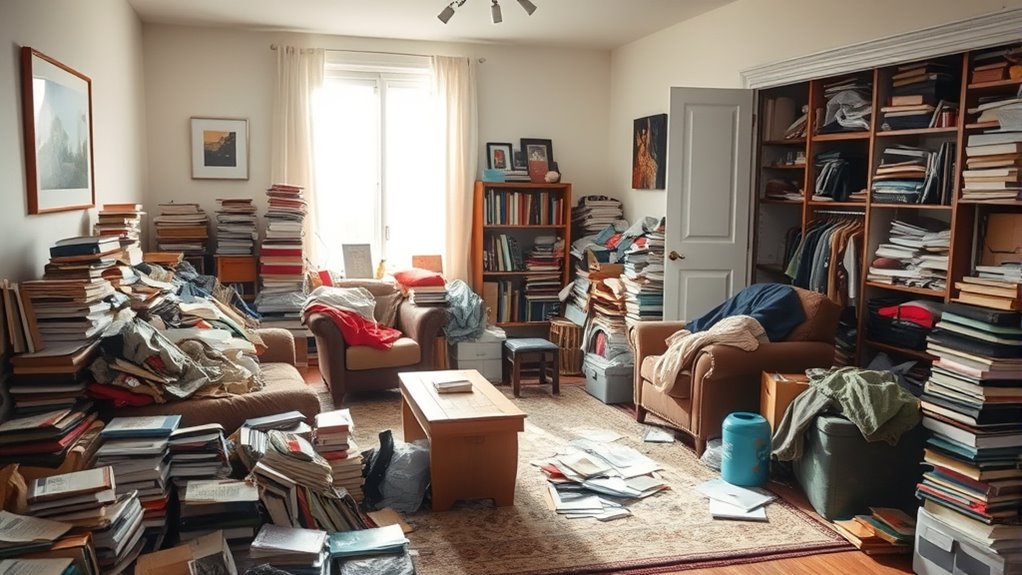
While a single decluttering session might offer immediate relief, it rarely provides a lasting solution. One-time decluttering can clear space temporarily, but without ongoing effort, clutter tends to return quickly. This approach doesn’t address the habits or emotional attachments that cause clutter in the first place. Many people find themselves back in a cluttered environment shortly after their initial effort. Relying solely on a one-time decluttering session often leads to frustration and feelings of failure when clutter reappears. To truly maintain order, you need sustainable progress—consistent habits and systems that prevent clutter from reaccumulating. Regularly assessing and rotating items can help in maintaining organization and prevent clutter from creeping back. Incorporating ongoing organizational routines can significantly enhance long-term clutter control. Creating a dedicated space for emotional attachments can help in managing sentimental items more effectively. Remember, decluttering isn’t a one-and-done task; it’s an ongoing process that requires regular attention to stay manageable. Additionally, implementing storage in a cool, dark place can help prolong the effectiveness of your decluttering efforts by maintaining organized spaces over time.
Why Systems Are Essential for Maintaining Order
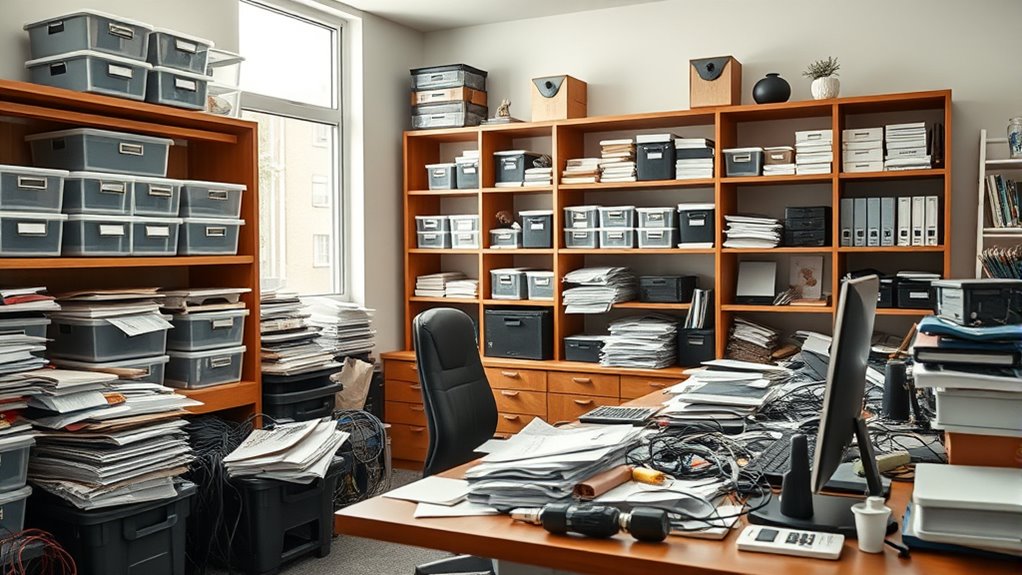
Implementing effective organizational systems is key to keeping your space tidy over the long term. Without these systems, clutter can quickly reappear, undoing your efforts. Well-designed systems create a structured approach, establishing designated spots for items and routines that keep your clutter-free home intact. Practical systems focus on functionality, using adaptable solutions instead of matching containers, making maintenance easier. They minimize the need for frequent reorganization by preventing chaos from building up again. When tailored to your habits and space, these systems ensure long-lasting order. For example, understanding floating on water can inspire calm and fluid organization strategies that adapt seamlessly to your changing needs. Recognizing the importance of attention to detail can help you identify areas where your systems may need refinement to maintain order effectively. To deepen your understanding, consider:
- Creating designated zones for different categories
- Using simple, accessible storage solutions
- Establishing routine check-ins for organization
- Adjusting systems based on your evolving needs
The Role of Habits and Mindset in Preventing Clutter
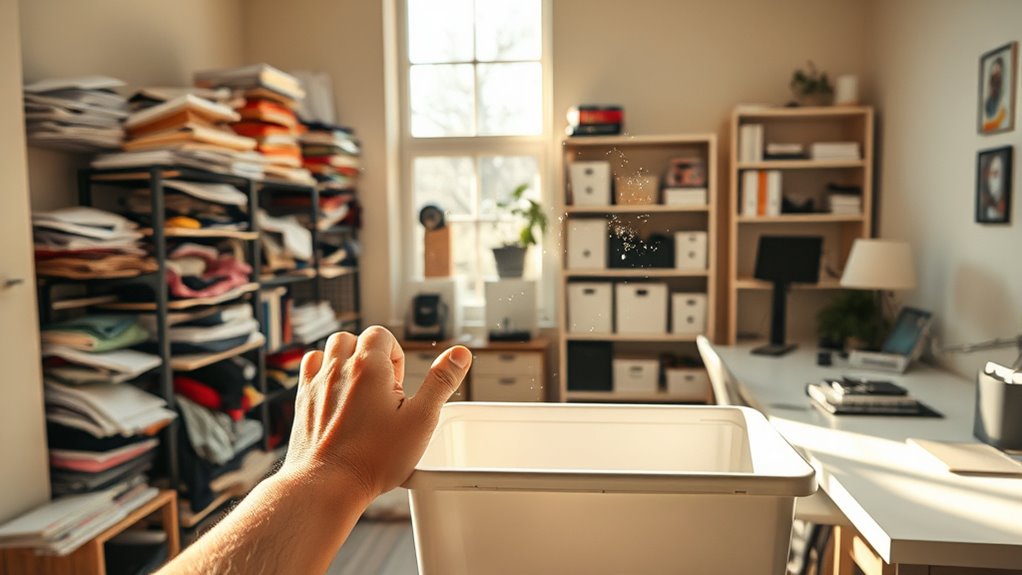
Your mindset plays a crucial role in preventing clutter from reaccumulating. When you shift your perspective on shopping and possessions, you reduce impulsive buys that quickly clutter your space. Developing mindful habits, like asking yourself, “Do I need this?” before purchasing, helps you avoid unnecessary items. Emotional attachments to sentimental objects can make decluttering tough, but changing your mindset to prioritize functional spaces over memories encourages healthier decisions. Forming new habits, such as “one in, one out,” creates lasting clutter control, unlike temporary cleanouts. Additionally, addressing underlying mental health issues, like anxiety or hoarding tendencies, with support can reinforce sustainable habits. Your attitude toward possessions shapes your environment, making it easier to maintain order and prevent clutter from returning. Understanding the importance of color accuracy and other image quality factors can also be applied metaphorically to organizing your environment, emphasizing clarity and intentionality in possessions. Recognizing how personality traits, such as impulsivity or conscientiousness, influence your clutter habits can help tailor more effective strategies. Moreover, exploring the compatibility of your habits with your personal tendencies can lead to more sustainable organizing solutions. Cultivating dynamic communication exercises for couples within your environment can foster cooperation and mutual understanding, making clutter management a shared effort. Incorporating mindful decision-making techniques, like hydrocolloid technology in skincare, can inspire similar approaches to evaluating possessions, ensuring only the most beneficial items stay.
The Cycle of Reorganizing Without Reducing Clutter

Reorganizing your space repeatedly without reducing clutter often feels like spinning your wheels, as items tend to come back quickly. This cycle can leave you frustrated, giving a false sense of order while the core problem remains. Without addressing the excess, efforts to tidy up will just keep repeating themselves. Incorporating clutter reduction techniques into your routine can help break this cycle and create lasting organization. For example, implementing a regular decluttering process ensures that you focus on removing unnecessary items rather than just reorganizing what you already have. Embracing virtual hackathons for brainstorming new organization strategies can also inspire innovative solutions to longstanding clutter issues. Additionally, understanding catering and delivery trends shows how convenience and efficient service are valued, highlighting the importance of simplifying your space to match modern lifestyles. Incorporating educational toys that promote organization and skill development can also encourage children to participate in maintaining a clutter-free environment, fostering independence and responsibility.
Endless Reorganization Efforts
Endless reorganization efforts often create a frustrating cycle where you shuffle items from one place to another without actually reducing clutter. This cycle leaves the core problem—excess possessions—unresolved, so clutter quickly reappears. Without addressing the root cause, reorganizing merely masks the mess temporarily. Studies show organizational systems fail long-term when habits and overaccumulation aren’t tackled. Think of a tower of blocks: rearranging without removing excess causes it to collapse repeatedly. To break this cycle, you need to:
- Recognize that reorganization alone isn’t enough.
- Focus on decluttering first, then reorganize.
- Avoid the trap of temporary tidiness.
- Understand that persistent clutter signals the need for fundamental change.
- Incorporating family photoshoot fails and pet antics can highlight areas needing decluttering. Additionally, understanding the importance of effective storage solutions can help maintain a clutter-free environment. Implementing mindful consumption can also prevent future accumulation and sustain long-term order.
Clutter and reorganization are interconnected; tackling one without the other leads to burnout and ongoing chaos.
Clutter Reappears Quickly
When you reorganize a cluttered space without addressing the underlying causes of getting rid of unnecessary items, the mess tends to come back quickly. New clutter fills the space almost immediately, making your efforts seem pointless. Repeatedly tidying without reducing your possessions traps you in a cycle where clutter keeps reappearing, leading to frustration. Without taking steps to minimize what you own, reorganizing only provides temporary relief. Clutter tends to reaccumulate rapidly when habits like impulsive shopping or emotional attachment remain unchanged. Studies show that spaces left cluttered after reorganizing often revert to their original state within days or weeks. To break this cycle, you need to focus on getting rid of items you no longer need or love, not just rearranging what’s already there.
Emotional Barriers That Hinder Decluttering Progress

Emotional barriers often stand in the way of decluttering efforts, as letting go of sentimental items can evoke strong feelings. Your emotional attachment to certain belongings can make it difficult to part with them, even if they no longer serve a purpose. Here are some common barriers:
- Fear of losing memories tied to possessions
- Guilt or shame about the state of your home
- Resistance due to past experiences or nostalgia
- Mental health challenges like anxiety or hoarding tendencies
- Understanding Textile Line techniques can sometimes aid in managing sentimental items more comfortably.
These feelings create mental blocks that hinder progress. Recognizing that emotional attachment is natural is the first step. To move forward, you might need to practice self-compassion or seek support to gently let go of items that no longer serve you.
Overcoming Overwhelm and Starting Small

Starting your decluttering journey can feel overwhelming, but breaking it into small, manageable tasks makes the process more approachable. Getting started is easier when you focus on tiny areas like a drawer or countertop, which reduces overwhelm and provides quick wins. Limit your sessions to 15-30 minutes to prevent fatigue and keep motivation high. Concentrate on one category at a time, such as mail or clothes, so the task doesn’t seem insurmountable. Breaking the process into daily or weekly small actions helps you make steady progress without feeling overwhelmed. Prioritize high-impact areas like the entryway or bedroom first, as they offer quick, satisfying results that encourage continued effort. Small steps build confidence and make decluttering sustainable. Exploring innovative storage solutions can also make it easier to organize and maintain your decluttered space. Additionally, setting realistic goals helps you stay motivated and track your progress effectively.
The Impact of Sentimental Attachments and How to Manage Them

As you work through decluttering, sentimental attachments often present a unique challenge. These emotional bonds to sentimental items make it difficult to let go, since they’re tied to memories rather than practical use. To manage this, consider these strategies:
Sentimental attachments challenge decluttering by tying items to memories rather than practicality.
- Digitize keepsakes like photos or letters to preserve memories without physical clutter.
- Set time limits for decision-making, giving yourself a deadline to choose what to keep or discard.
- Focus on the feelings, recognizing that memories are stored in your mind, not in objects.
- Prioritize meaningful items over everything else, letting go of lesser sentimental pieces.
Understanding that emotional attachment is rooted in feelings, not the item’s worth, helps you make more mindful, compassionate choices when decluttering.
Why Regular Maintenance Is Key to Long-Term Success

Maintaining a clutter-free space requires consistent effort, as even small, daily habits can substantially impact long-term organization. Regular maintenance, like weekly decluttering sessions, prevents clutter from piling up and becoming overwhelming. Applying the “one in, one out” rule helps keep possessions in check and avoids unnecessary buildup. Scheduling routine checks and reorganizations ensures your space remains functional and suited to your current needs. Small habits, such as putting items away immediately, add up over time to sustain order. Without ongoing upkeep, even the most organized spaces tend to revert to cluttered states, making initial decluttering efforts less effective. Prioritizing regular maintenance is essential for long-term success, keeping your space tidy and manageable with less effort over time.
Common Decluttering Mistakes and How to Avoid Them

Many people make the mistake of trying to declutter their entire home at once, which often leads to burnout and frustration. To make real progress, avoid these common mistakes:
- Tackling large areas without breaking them into manageable tasks, hindering decluttering progress.
- Focusing only on reorganizing or tidying, which keeps clutter from actually being removed.
- Ignoring emotional attachments or habits that cause clutter to reappear quickly.
- Targeting the wrong areas or surface clutter, missing the deeper issues that prevent lasting change.
Shifting Focus From Tidying to Behavioral Change

Shifting your focus from merely tidying to making lasting behavioral changes is essential for sustainable decluttering. Behavioral change involves creating daily habits, like putting items away immediately, which gradually reduces clutter over time. Studies show that organizing spaces without addressing underlying habits often results in clutter returning within weeks, emphasizing the need for mindset shifts. By changing how you react to new possessions—asking yourself, “Do I need this?”—you can prevent unnecessary accumulation. Techniques like the “one in, one out” rule help embed sustainable organizational behaviors that surpass simple tidying routines. Prioritizing behavioral change over quick fixes leads to a more consistent, clutter-free environment that requires less frequent reorganizing, making decluttering a long-term success rather than a temporary fix.
Frequently Asked Questions
Why Am I Struggling to Declutter?
You’re struggling to declutter because you might feel overwhelmed without a clear plan, and emotional attachments make it hard to let go. Maybe you’re waiting for the perfect moment or feel stuck due to mental health challenges. This cycle causes frustration and guilt, making it even harder to start. Instead of aiming for perfection, break it into small steps, focus on progress, and be kind to yourself throughout the process.
What Is the 9090 Rule?
Imagine your decluttering efforts as a marathon, not a sprint. The 9090 Rule helps you pace yourself by working for 90 minutes, then taking a 90-minute break. This keeps you energized and focused, preventing burnout. Instead of exhausting yourself with endless tidying, you create sustainable habits that make decluttering manageable. Follow this rhythm, and you’ll find progress feels less overwhelming and more achievable.
What Is the 50% Rule in Decluttering?
The 50% Rule in decluttering means you aim to keep only about half of your possessions. You evaluate each item to see if it adds value or serves a purpose, making decisions easier and reducing emotional attachment. By applying this rule, you create a more minimalist space, which leads to less clutter and clearer mental focus. It’s a practical way to set achievable goals and keep your decluttering efforts sustainable.
What Is Another Way to Start Getting Rid of Clutter?
Imagine you’re overwhelmed by clutter, but instead of tackling everything, start small. Pick one drawer or countertop and clear it out. You’ll see quick results, boosting your motivation. Use the “one in, one out” rule to keep new clutter in check. Setting a timer for 15-30 minutes makes it manageable. Focusing on non-emotional categories like mail or clothes you no longer wear helps you build confidence and momentum.
Conclusion
To truly transform your space, ditch the intimidating declutter dance. Develop dedicated habits, build simple systems, and break free from sentimental snares. Consistent, conscious choices create clean, clutter-free comfort. Remember, lasting order isn’t a one-time wonder but a continuous cycle of mindful maintenance. Embrace small shifts, stay steady, and let your space flourish from frustration into freedom. With patience and persistence, you’ll finally foster a clutter-free, calm, and conquering coexistence.
